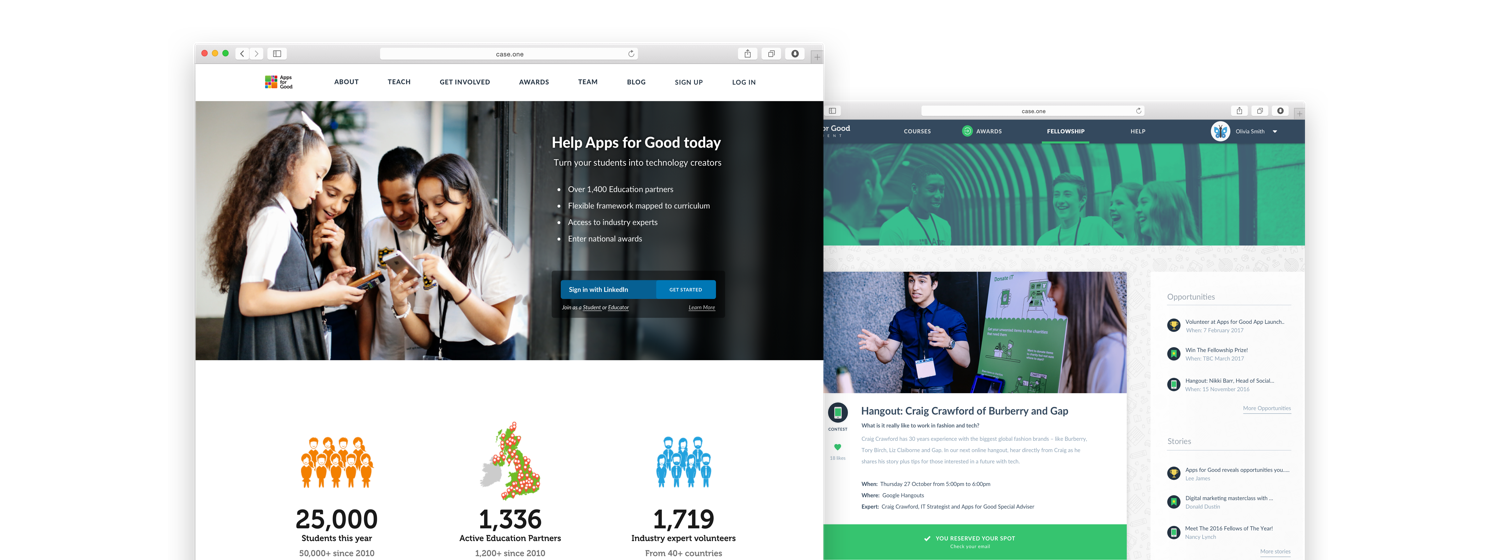Top Companies Using Ruby on Rails

But why do so many developers and businesses choose Ruby on Rails, and what makes it stand out from other frameworks? Rails development companies are instrumental in leveraging the framework's capabilities, offering expertise in building web applications rapidly and cost-effectively.
In this blog post, we’ll explore the advantages of using Ruby on Rails for web development, delve into the top Ruby on Rails website examples, and share valuable tips to help you build a successful Ruby on Rails website. Get ready to uncover the secrets behind the success of Ruby on Rails!
What is Ruby on Rails?
Definition and Overview
Ruby on Rails, often referred to simply as Rails, is a powerful server-side web application framework written in the Ruby programming language. It has become a popular choice for web development due to its rapid development capabilities, scalability, and ease of maintenance.
Rails is an open-source framework that follows the Model-View-Controller (MVC) architectural pattern, which divides a web application into three interconnected components: the model, the view, and the controller. This separation of concerns allows developers to build complex web applications quickly and efficiently, making Rails an ideal choice for a wide range of web applications.
Why Choose Ruby on Rails for Web Development?
A growing number of developers and companies worldwide have embraced the power of Ruby on Rails for web development. This framework, built on the Ruby programming language, offers an efficient environment for creating high-performance web applications. The unique blend of scalability, flexibility, and MVC (Model-View-Controller) structure makes Ruby on Rails an ideal choice for various industries and types of web services, including social media platforms and online marketplaces.
To ensure project success, it is crucial to select a reputable rails development company. These companies bring expertise, experience, and overall value to web application development projects.
But what makes Ruby on Rails so special? To answer this question, let’s delve deeper into its core advantages: scalability, flexibility, and MVC structure.
Scalability
Scalability is the ability of a system or organization to handle an increase or decrease in workload or demand while maintaining performance and functionality. Ruby on Rails is known for its rapid development capabilities, making it a popular choice for scalable web application development. To ensure scalability, Ruby on Rails can implement horizontal scaling and service-based architecture, making it suitable for developing web apps that need to handle growing workloads.
The scalability provided by Ruby on Rails is a major driving force behind its adoption by various businesses. With a technology stack that can adapt to increasing demands, Rails applications can continue to thrive as they grow, ensuring long-term success and stability.
Flexibility
Ruby on Rails offers remarkable flexibility through its extensive libraries, integrations, and active community. This flexibility allows a rails developer to create tailored solutions for different business needs, making it a versatile choice for various industries. For example, Rails powers Zendesk’s backend services and facilitates integration with client applications through its multipurpose APIs, streamlining the development process for companies like Zendesk. Zendesk, a cloud-based customer support platform, showcases the expertise of Rails developers in creating efficient and scalable web applications.
The flexibility of Ruby on Rails enables businesses to:
-
Adapt to changing requirements,
-
Innovate and expand their offerings,
-
Stay ahead of the curve,
-
Meet the ever-evolving demands of their customers.
By leveraging the power and adaptability of Rails, local businesses can achieve these goals.
MVC Structure
The MVC (Model-View-Controller) structure is an architectural pattern that divides a web app into three distinct components: the model, the view, and the controller. The model handles data and business logic, the view displays the user interface, and the controller manages the communication between the model and the view. Adopting an MVC structure encourages a clear division of responsibilities, facilitating maintenance and updates to the codebase. This structure also enables improved code organization and scalability, making Ruby on Rails a popular choice among programming languages for web development.
Benefits of Using Ruby on Rails for Web Development
Ruby on Rails offers numerous benefits for web development, making it a preferred framework for many developers and businesses. One of the standout features of Rails is its rapid development capabilities, which allow developers to build web applications quickly and efficiently. This is largely due to Rails’ convention over configuration approach, which minimizes the need for boilerplate code and streamlines the development process.
Scalability is another significant advantage of Ruby on Rails. The framework is designed to handle high-traffic and complex applications, making it suitable for businesses that anticipate growth. Additionally, Rails boasts a large and active community of developers who contribute to an extensive library of gems—pre-packaged code that extends the functionality of Rails applications. This community support ensures that developers have access to a wealth of resources and tools to enhance their web development projects.
The MVC structure and active record pattern of Rails also contribute to its ease of maintenance and codebase updates. By organizing code into distinct components, Rails makes it simpler to manage and scale applications over time.
Top Ruby on Rails Website Examples
Now that we’ve explored the benefits of Ruby on Rails, let’s take a closer look at some of the top online platforms built using this incredible framework. Here are some examples:
-
Airbnb: An online marketplace for booking accommodations around the world.
-
Shopify: An e-commerce platform that allows businesses to create and manage their online stores.
-
Twitch: A live streaming platform primarily focused on video game streaming.
-
Couchsurfing: A social networking platform that connects travelers with local hosts for accommodation.
These Rails-powered websites showcase the versatility and effectiveness of Ruby on Rails in various industries, proving the value of Rails companies.
Keep reading to discover more about the success stories behind these Rails website examples and how they’ve leveraged the power of Ruby on Rails to achieve greatness.
1. Airbnb
Airbnb, the popular online platform that connects travelers with hosts, uses Ruby on Rails for its backend architecture. The choice of Rails as the foundation for Airbnb’s platform brings numerous advantages, such as scalability, flexibility, and API integration capabilities. With over 150 million users worldwide and the ability to handle around 60 billion images per month, the scalability offered by Ruby on Rails is crucial for the success of Airbnb.
The flexibility of Ruby on Rails also enables Airbnb to adapt to the ever-changing landscape of the travel industry and continuously evolve its platform. By leveraging the powerful capabilities of Ruby on Rails, Airbnb has become a global leader in the online marketplace for accommodations and experiences.
Airbnb hosts offers from over 191+ countries having provided services to over 260 million peopleworldwide with the number of listings already surpassing 4 million.

2. Crunchbase
Some call Crunchbase the Wikipedia for startups – it's the ultimate go-to website if you want to find out who stands behind innovative companies or invest in the projects you love the most. Formerly powered by TechCrunch, one of the largest tech news portals.
Crunchbase's back end was written on Ruby on Rails, with Varnish for page caching and has since evolved.

3. Ask.fm
Ask.fm is an interest-based social Q&A website and started as a place where users from around the globe ask anonymous questions to random people – responses can also be received anonymously. The site raised a lot of controversy caused by cyberbullying episodes due to this model of anonymity but has since changed to a registered profile model to combat this.
It was founded in Riga, Latvia in 2010 and has 215 million users.

4. Bloomberg
Bloomberg provides financial software tools such as an analytics and equity trading platform, data services, and news to financial companies and organisations. Their media platform combines stock share indexes, breaking news from the world of international politics, technological novelties, and much more.
Bloomberg’s traffic exceeds 100 million users every month and has a whopping $9.6 billion in revenue – founded by Michael Bloomberg on December 31, 2014.

5. Dribbble.com
One of our favourite design directories! Dribbble.com is a community where designers can present their work, exchange opinions, collect their favourite images of other artists, or look for career opportunities. If you want to see how Dribbble works, check out our profile and the discussions under the shots.
Founded in 2009 by Dan Cederholm and Rich Thornett, it receives over 4 million visitors a month.

6. GitHub
GitHub, the renowned code-hosting platform used by developers to collaborate, share, and manage their projects, employs Ruby on Rails to effectively manage a vast number of projects and process a high volume of project management requests. With more than 100 million projects regularly modified and updated on GitHub, the robust testing mechanisms and efficient handling of large volumes of requests offered by Ruby on Rails are vital for the platform’s success.
Moreover, the APIs created by GitHub using Ruby on Rails, a popular rails framework, comply with REST design principles, making it easier for developers to integrate and work with these APIs. The choice of Ruby on Rails as the backbone of GitHub’s infrastructure showcases the framework’s strength in handling complex and large-scale applications.
Headquartered in San Francisco, the site went live on July 21, 2008.

7. Fiverr
Fiverr.com is a global online marketplace offering tasks and services, referred to as ‘gigs’, and micro-jobs starting at $5.00 for each job performed. It has over 3 million gigs listed over 100 different categories in 190 countries.
Headquartered in NYC, the site was founded by Micha Kaufman and Shai Wininger in 2009.

8. Yellow Pages
YellowPages is an online service that allows you to search local listings for businesses, as well as contacts. The site has been ranked as one of the top 40 U.S. Web domains with more than 60 million visitors each month in the U.S.
YP is the original source people use to find and connect with local businesses – it launched in May 2012 bringing together AT&T Interactive and AT&T Advertising Solutions.

9. COOKPAD
COOKPAD is Japan’s largest recipe site allowing visitors to upload and search through original user-created recipes. According to them, Cookpad is currently being used by almost half of all Japanese women in their 20s or 30s. COOKPAD had a total of 100 million users and more than 4 million uploaded recipes.
Founded on 1 October 1997 by Akimitsu Sano, the company is headquartered in Tokyo, Japan.

10. Helpling
Helpling is a platform that offers home cleaning services and connects cleaners with homeowners. The company targets several markets, including the UK, Germany, Australia and France. This Ruby on Rails app includes a wide range of functionalities, including search tools for both cleaners and homeowners, sign-up, account management, and secure payments.
The service covers over 200 cities worldwide, and has already been used by over 100,000 clients.

11. Apps for Good
Apps for Good is an NGO that partners with educators to deliver its technology learning courses to young people between 8– 18 years of age. Its courses have been available to teachers through a dedicated e-learning platform since 2012.
Apps for Good helps more than a thousand schools, and tens of thousands of students around the globe every year.

12. Artemest
Artemest is an Italian e-commerce site featuring a collection of curated home décor, jewellery, and lifestyle art created by top Italian artists. Their mission is to preserve the heritage of the best Italian artisans by connecting them with customers from around the world – in many cases the artists featured on the Artemest platform would have had to shut their businesses down if it weren’t for the additional customers won through the website.
They have grown exponentially, building a community of artists and curators around its business. The platform has been featured in Forbes, The New York Times and Elle.

13. Intellection
Intellection is a market research platform for big corporations such as Kantar, TNS, Ipsos and Pondering Panda. The company offers a broad range of products and tools which allow clients to measure the effectiveness of their advertising, conduct surveys, analyse the results, and verify the strength of a brand’s equity – in hours, not weeks.
Based on the analyses derived from such tools, businesses can make informed, accurate business decisions.

14. SlideShare
SlideShare.net is a Web 2.0-based slide hosting service with 80 million users and 159 million page views – users can upload their PowerPoint, PDF, or OpenOffice presentations and share them privately or publicly.
Founded in October 2006, SlideShare is currently headquartered in San Francisco and is owned by LinkedIn Corporation.

15. 500px
500px is a massive community of over 15 million photographers who can share their work on the platform, expand their creative networks of friends, colleagues and mentors, learn new technical and aesthetic skills and make money on selling photos.
The company was founded in October 2009 and is based in Toronto, Canada and receives over 2.5 million visitors a month.

16. Zendesk
Zendesk is a service software company that helps companies improve customer relationships through higher customer engagement and better customer insights. It now has over 2,200 employees and serves 125,000 paid customers in 160 countries and territories.
It was founded by Mikkel Svane in August 2007 with headquarters in San Francisco.

17. Soundcloud
SoundCloud, the music streaming platform initially developed for musicians to share their music, started with Ruby on Rails for its versatility and scalability. However, as the platform grew and evolved to become a publishing platform for emerging artists, SoundCloud later transitioned to JVM.
Despite the transition away from Ruby on Rails, the framework played a crucial role in the early stages of SoundCloud’s development. By providing a strong foundation for the platform, Rails helped SoundCloud establish itself as a major player in the music streaming industry.

18. Clarity
Clarity is an online platform that connects people who seek advice in areas such as marketing, sales, venture capital, customer acquisition, and business development with experts and mentors. Users can browse or search the community of business professionals to find the right person and then schedule a call.
According to Clarity, every 90 seconds a startup is in on the phone with an expert and over 73,000 calls have been already completed.

19. Couchsurfing
Couchsurfing, the online platform that connects travelers with hosts worldwide, uses the following technologies for its backend development and maintenance:
-
Ruby on Rails
-
SCSS
-
Redis
-
MySQL
-
JavaScript
-
Thumbor
-
SOLR
These technologies work together to create a seamless experience for Couchsurfing users.
The choice of Ruby on Rails as the foundation for Couchsurfing’s backend architecture showcases the framework’s ability to power community-driven platforms. By leveraging the capabilities of Rails, Couchsurfing has successfully created a global network of travelers and hosts, fostering connections and enriching travel experiences.
The couchsurfing community is massive – in 2018 the site had 15 million members and 400,000 active hosts.

20. Crazy Egg
Crazy Egg is one of the most popular website heatmap service providers –founded by Neil Patel and Hiten Shah, the gurus of online marketing, Crazy Egg enables marketers and website owners to improve their website content and architecture based on user behaviour.
Crazy Egg comes with four powerful tools that help identify the most popular areas of a given page visually, see which parts of a page are working and which ones are not, check comprehensive analytics that are not provided by Google Analytics, and gain insight into what users are doing on site pages.

21. Groupon
Groupon is a worldwide e-commerce marketplace connecting subscribers with local merchants by offering activities, travel, goods and services in more than 28 countries. It helps mostly small businesses attract and retain customers by providing them with marketing tools and services to reach prospects and profitably grow their businesses.
Groupon serves more than 500 cities worldwide and has 53 million active users at any time – it features more than 425,000 active deals globally.

22. Indiegogo
Indiegogo is an international crowdfunding website that helps creative inventors find resources to fund their ideas. Entrepreneurs can start a crowdfunding campaign and get access to a huge community that can help them raise money. Funds can be collected even after the campaign is over with no target and no deadline limits. On top of that, it comes with a handful of useful tools and services such as manufacturing and logistics consulting.
Creators have already raised over $1,6 billion in over 800 thousand projects from over 11 million contributors – it operates in over 230 countries and territories.

23. Kickstarter
Kickstarter, the successful crowdfunding platform that enables users to find funding for their projects or support other users’ ideas, was created using Ruby on Rails to handle increasing user interactions and project management. In conjunction with Ruby on Rails, Perl language was also employed in the development of Kickstarter.
Scalability and rapid development capabilities offered by Ruby on Rails have been key factors in the success of Kickstarter. With millions of projects funded and countless ideas brought to life, Kickstarter’s choice of Rails as its backbone showcases the framework’s ability to power innovative and rapidly growing platforms.
Since their launch on April 28, 2009, 18 million people have backed a project, $5 billion has been pledged, and 188 thousand projects have been successfully funded.

24. Pixlr
Pixlr is a cloud-based set of image tools for photo editing, and sharing. Initially, the suite was targeted at non-professionals but now the apps range from simple to advanced photo revamping – it offers tools for both desktop computers and mobile devices.
Pixlr was founded in Sweden in 2008 by Ola Sevandersson – the mobile app has been installed over 100 million times.

25. Scribd
Scribd is a digital library based on a subscription model in which users have access to a pool of over one million eBooks and audiobooks. In the basic plan a user gets access to x3 books, x1 audiobook and unlimited access to magazines and documents each month.
Scribd has now 100 million active users and has been dubbed “the Netflix for books” – it’s available in 194 countries and was founded in March 2007 in San Francisco.

26. MyFitnessPal
MyFitnessPal offers a free app for both web and mobile that helps users lose weight by keeping track of the foods they eat and how much they exercise. It provides access to a nutrition and calorie database with over 5 million foods.
MyFitnessPal was rated the best free app with an overall satisfaction score of 83 and top marks for maintenance, calorie awareness, and food variety – it released in 2005.

27. Shopify
Shopify, the leading e-commerce platform that powers over 600,000 online vendors, was built using Ruby on Rails. Rapid development and robust backend support provided by Rails have enabled Shopify to handle up to 80,000 requests per second and serve nearly 1,000,000 businesses across 175 countries.
The flexibility and scalability offered by Ruby on Rails make it an ideal choice for an e-commerce platform like Shopify, which must adapt to the ever-changing needs of its merchants and customers. By using Ruby on Rails, Shopify has established itself as a dominant player in the e-commerce industry, providing a feature-rich platform for businesses of all sizes to thrive.
This Canadian site was founded by Tobias Lütke in April 2008.

28. Urban Dictionary
Urban Dictionary is a crowdsourced online dictionary of slang words and phrases– it was founded in 1999 as a parody of Dictionary.com and Vocabulary.com and has gained massive popularity as the ‘go to’ place for all things slang.
Urban Dictionary has 75 million unique readers every month – it was founded in San Francisco by Aaron Peckham in 1999.

29. Whitepages
Whitepages is the largest online directory with contact information and public records for over 90% of US adults – it provides access to people, telephone numbers, addresses, and all the other contact information you might need.
Founded in 1997, it started out as a hobby by Alex Algard – it now has over 50 million unique users every month!

30. Yammer
Yammer is a freemium enterprise social networking service used for private communication within organisations. It facilitates joining and creating groups, getting answers to questions even when you’re not sure whom to ask, collaborating with contractors, customers or sister companies and keeping all the docs, photos and videos in context by adding them to conversations – Yammer comes with a mobile app for iOS and Android.
It was founded in 2008 by David O. Sacks and Adam Pisoni, parented by Microsoft Corporation.

31. Twitch
Twitch, the live video streaming platform and social media network specifically designed for online gaming, was built on Ruby on Rails to support its growing user base and content delivery. With approximately 2.2 million people streaming on Twitch each month, the scalability and performance offered by Ruby on Rails are essential for the platform’s success.
The choice of Ruby on Rails for Twitch’s backend infrastructure highlights the framework’s ability to power high-traffic, content-heavy platforms. By leveraging the strengths of Rails, Twitch has been able to grow into a leading live video streaming platform enjoyed by millions of users worldwide.

32. We Heart It
We Heart is a photo-based social network – it’s a visual platform that supports still images, animated GIFs, and video. They describe themselves as the ‘home of inspiration’ and the place to ‘organize and share the things you love’.
We Heart It was officially formed in December 2007 in Brazil – the company is now based in San Francisco.

33. GoodReads
Goodreads is the world’s largest site for readers and book recommendations – users can see their friends’ bookshelves and learn about what they thought of all their books.
Goodreads launched in January 2007, and the company is located (surprise, surprise!) in San Francisco.

34. ThemeForest
ThemeForest is an online marketplace specialising in website templates and Wordpress themes with over 10,000 themes to choose from. The platform launched in 2008 and is the product of Envato, a self-funded startup that operates a group of digital marketplaces that sell creative assets for web designers, including themes, graphics, video, audio, photography and 3D models.
It’s headquartered in Melbourne, Australia and has over 2.4 million unique visitors per month.

35. Hulu
Hulu, the popular video streaming platform, was built using Ruby on Rails for its backend architecture, while Backbone.js powers its front end. The choice of Rails as the foundation for Hulu’s platform highlights the framework’s ability to handle large-scale, high-performance applications.
The scalability and efficiency offered by Ruby on Rails have been instrumental in Hulu’s success as a leading video streaming platform. By leveraging the power of Rails, Hulu can continuously enhance its content delivery and provide seamless streaming experiences to millions of users worldwide.
Summary
Throughout this blog post, we have explored the benefits of Ruby on Rails for web development, delved into some of the top website examples built with this powerful framework, and shared valuable tips to help you build a successful Ruby on Rails website. The scalability, flexibility, and MVC structure offered by Rails make it an ideal choice for various industries and applications, as demonstrated by the success stories of Airbnb, GitHub, Shopify, Hulu, and many others. By embracing Ruby on Rails and following best practices, you too can unlock the potential of this incredible framework and build your own masterpiece.


